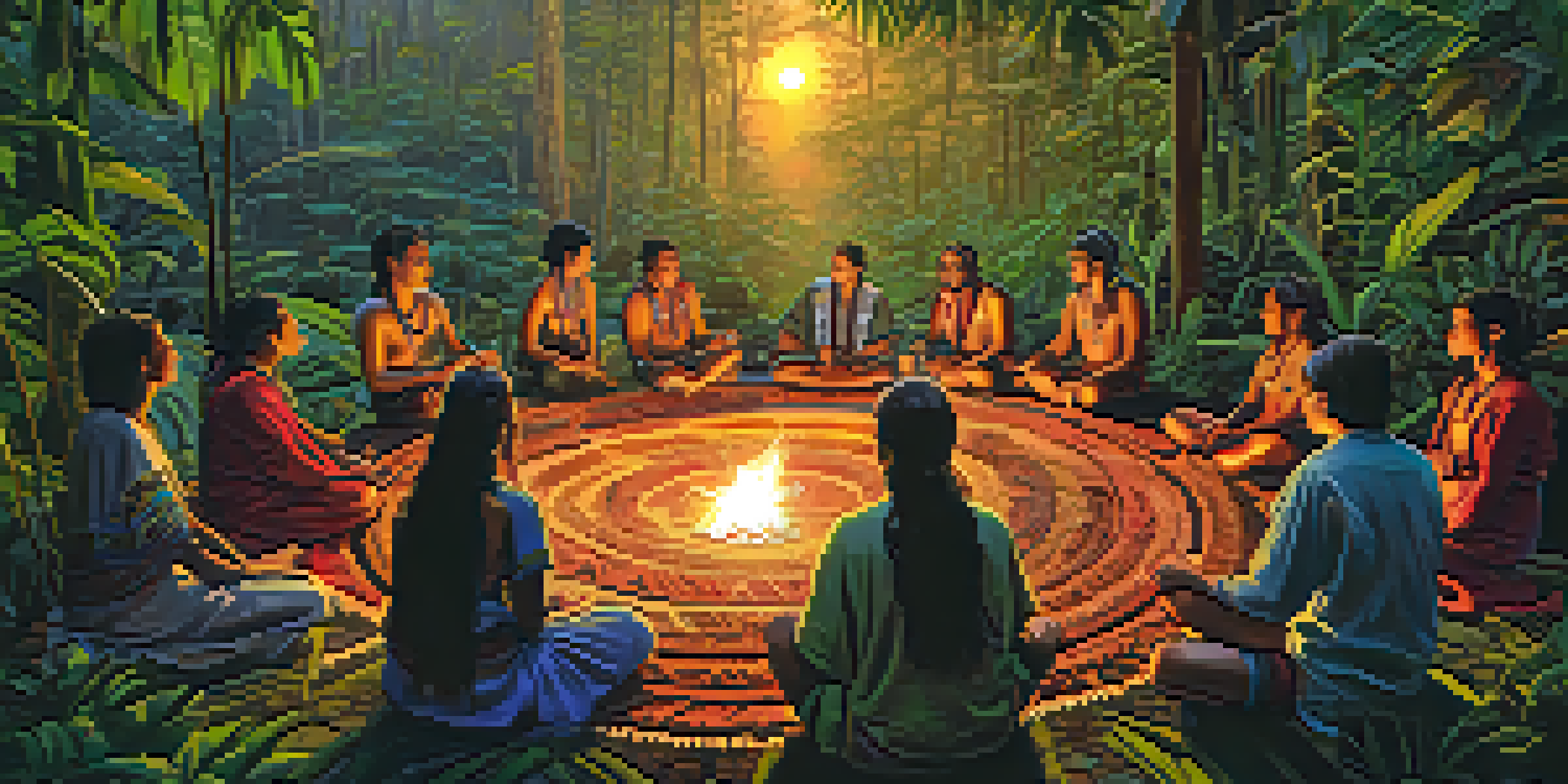The Intersection of Ayahuasca and Indigenous Language Preservation

Understanding Ayahuasca and Its Cultural Significance
Ayahuasca is a traditional Amazonian brew made from the Banisteriopsis caapi vine and other plants. It has been used for centuries by indigenous communities for spiritual and healing purposes. Beyond its psychoactive effects, Ayahuasca is deeply woven into the cultural fabric of these communities, often serving as a medium for storytelling, rituals, and communal bonding.
Language is the roadmap of a culture. It tells you where its people come from and where they are going.
The brew's significance goes beyond personal transformation; it is also a vessel for transmitting knowledge, history, and language. Many indigenous groups rely on Ayahuasca ceremonies to pass down oral traditions, which are crucial for maintaining their unique languages. This practice highlights the interplay between spirituality and linguistic heritage in indigenous cultures.
As globalization threatens many indigenous languages, understanding the cultural importance of Ayahuasca becomes vital. It not only shapes individual identities but also serves as a powerful tool for community cohesion, reinforcing the need to preserve both the language and the traditions that accompany it.
The Role of Language in Indigenous Identity
Language is more than a communication tool; it embodies a community's identity and worldview. For indigenous peoples, their languages encapsulate ancestral wisdom, cultural practices, and historical narratives. When a language fades, so does the connection to these vital aspects of their identity.

Many indigenous communities view language preservation as an act of resistance against cultural erasure. By maintaining their languages, they ensure that future generations carry forward their unique perspectives and ways of life. This is where Ayahuasca can play a crucial role, as it often serves as a backdrop for language use in ceremonial contexts.
Ayahuasca's Cultural Importance
Ayahuasca serves as a vital medium for indigenous communities, facilitating spiritual healing and the transmission of language and culture.
Through Ayahuasca ceremonies, participants engage in rich linguistic exchanges, which can revitalize the use of their native languages. This not only strengthens individual and community identities but also fosters a sense of pride and belonging among younger generations.
Ayahuasca Ceremonies as Linguistic Repositories
Ayahuasca ceremonies often involve intricate rituals that require participants to communicate in their indigenous languages. These ceremonies are not just spiritual experiences; they are also rich linguistic events where traditional stories, songs, and teachings are shared. Such gatherings become living repositories of language, capturing the nuances and rhythms unique to each community.
Cultural preservation is not just about saving the past; it's about ensuring a future where diverse voices are heard.
As elders narrate stories in their native tongues, they not only impart wisdom but also model language use for younger participants. This dynamic interaction reinforces language learning and encourages younger generations to engage with their linguistic heritage actively. In this way, Ayahuasca becomes a catalyst for both spiritual and linguistic continuity.
Moreover, the rhythmic chants and songs sung during these ceremonies play a significant role in language retention. They create a memorable auditory experience that aids in language acquisition, making it easier to remember and reproduce indigenous words and phrases.
Challenges to Indigenous Language Preservation
Despite the rich traditions surrounding Ayahuasca, indigenous languages face significant threats. Factors such as globalization, urban migration, and the dominance of colonial languages contribute to the decline of these languages. With fewer speakers, many indigenous languages are classified as endangered, putting their survival at risk.
Within this context, Ayahuasca can be both a refuge and a challenge. While it provides a platform for the use of indigenous languages, the increasing popularity of Ayahuasca outside of indigenous communities can dilute its cultural significance. This raises concerns about cultural appropriation and the potential marginalization of the very languages that Ayahuasca ceremonies seek to preserve.
Language Preservation Efforts
Indigenous communities are actively working to preserve their languages through initiatives that combine traditional practices like Ayahuasca ceremonies with modern educational methods.
The challenge lies in balancing the growing interest in Ayahuasca with the need to protect and promote indigenous languages and cultures. Efforts must be made to ensure that these practices remain rooted in their original contexts and that indigenous voices are prioritized in discussions about language preservation.
Community-Led Efforts for Language Revitalization
Many indigenous communities are actively engaging in language revitalization efforts to counteract the decline. These initiatives often combine traditional practices, such as Ayahuasca ceremonies, with modern educational methods. By integrating language learning into daily life and cultural practices, these communities aim to create a sustainable future for their languages.
For instance, some communities have developed language immersion programs that utilize Ayahuasca rituals as a framework for teaching. Participants not only learn the language but also experience its cultural significance firsthand. This immersive approach fosters a deep connection to the language and its roots, making the learning process more meaningful.
Furthermore, community-led documentation projects are emerging to record and preserve languages at risk of extinction. Through audio recordings of Ayahuasca ceremonies and other cultural practices, these projects aim to create resources that future generations can use to learn and revitalize their languages.
The Impact of Technology on Language Preservation
In the digital age, technology plays a pivotal role in language preservation efforts. Indigenous communities are increasingly utilizing social media platforms and mobile applications to promote their languages and cultural practices. These tools enable wider reach and engagement, helping to attract younger audiences who are crucial for language revitalization.
For example, some groups are creating online spaces where Ayahuasca experiences and indigenous languages can be shared. This not only fosters a sense of community but also encourages the exchange of knowledge and traditions across geographical boundaries. The internet becomes a bridge connecting speakers and learners, regardless of distance.
Technology's Role in Revitalization
The digital age offers new avenues for language preservation, enabling indigenous communities to share their languages and cultural practices with a broader audience.
However, the challenge remains to ensure that these technological initiatives respect and reflect the cultural integrity of the languages they aim to preserve. Collaboration with indigenous leaders and language speakers is essential to ensure that technology serves as a supportive tool rather than a replacement for traditional practices.
The Future of Ayahuasca and Language Preservation
Looking ahead, the intersection of Ayahuasca and indigenous language preservation holds promising potential. As awareness of the importance of indigenous cultures and languages continues to grow, there is an opportunity for collaboration that respects and honors these traditions. Integrating language preservation efforts with Ayahuasca practices can lead to a holistic approach that benefits both.
Incorporating education about Ayahuasca into language preservation initiatives can also raise awareness among non-indigenous audiences. By understanding the cultural context of Ayahuasca, people can appreciate the significance of language and its role in indigenous identity. This fosters respect and support for indigenous communities and their efforts.

Ultimately, the future of Ayahuasca and indigenous language preservation hinges on mutual respect and collaboration. By valuing indigenous knowledge and practices, we can create pathways that not only honor the past but also empower future generations to carry their languages forward.